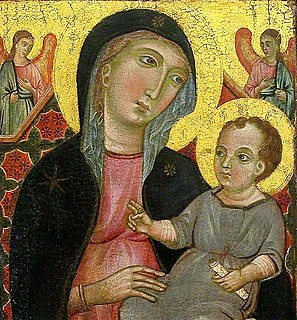
Giovanni Francesco Barbieri, better known as Guercino, or il Guercino[ɡwerˈtʃiːno], was an Italian Baroque painter and draftsman from Cento in the Emilia region, who was active in Rome and Bologna. The vigorous naturalism of his early manner contrasts with the classical equilibrium of his later works. His many drawings are noted for their luminosity and lively style.

Guido Reni was an Italian painter of the Baroque period, although his works showed a classical manner, similar to Simon Vouet, Nicolas Poussin, and Philippe de Champaigne. He painted primarily religious works, but also mythological and allegorical subjects. Active in Rome, Naples, and his native Bologna, he became the dominant figure in the Bolognese School that emerged under the influence of the Carracci.

Giovanni Lanfranco was an Italian painter of the Baroque period.

The Accademia di San Luca is an Italian academy of artists in Rome. The establishment of the Accademia de i Pittori e Scultori di Roma was approved by papal brief in 1577, and in 1593 Federico Zuccari became its first principe or director; the statutes were ratified in 1607. Other founders included Girolamo Muziano and Pietro Olivieri. The Academy was named for Luke the Evangelist, believed to be the patron saint of painters.

Antonio Visentini was an Italian architectural designer, painter and engraver, known for his architectural fantasies and capricci, the author of treatises on perspective and a professor at the Venetian Academy.

Domenico Maria Canuti was an Italian painter of the Baroque period, active mainly in Bologna and Rome. He was a major painter of fresco decorations. His ceiling decorations showed a mix of Bolognese and Roman influences.
Giovanni Gioseffo dal Sole was an Italian painter and engraver from Bologna, active in the late-Baroque period. Upon the death of Carlo Cignani, Gioseffo dal Sole became among the most prominent painters in Bologna, described as the Guido Moderno.

Giacinto Brandi was an Italian painter from the Baroque era, active mainly in Rome and Naples.
Ferdinando Orlandi, also referred to as Orland and Orlando. Little is known of his early life and his year of birth is also cited as 1777. He was an Italian musician and teacher of singing who composed cantatas and sacred music, but was particularly known for his operas, not all of which have survived. He was born and died in Parma.
Orlandi or the House of Orlandi were the prominent medieval Pisan family.

Giacomo Legi was a Baroque painter of Flemish descent who was active principally in northern Italy during the first half of the 17th century. Here he was one of the leading painters of still lifes and market and pantry scenes.

Romolo Panfi was an Italian painter, active in Tuscany. He was active mainly as a battle painter and landscapes.

Deodato Orlandi was an Italian painter who was active in Lucca and Pisa. His work marks the transition from the Italo-Byzantine painting of the 13th century to the Giotto-inspired style of the 14th century.

Stefano Orlandi was an Italian painter, active mainly in Bologna in the architectural perspective painting. He is known for painting fanciful architectural canvases, known as Capricci.
Ugo Orlandi is a musicologist, a specialist in the history of music, a university professor and internationally renowned mandolinist virtuoso. Among worldwide musicians, professional classical musicians are a small group; among them is an even smaller group of classical mandolinists. Among members of this group, Ugo Orlandi is considered "distinguished." Music historian Paul Sparks called him "a leading figure in the rehabilitation of the eighteenth-century mandolin repertoire, having recorded many concertos from this period."
Gentile Zanardi was an Italian painter, active in the Baroque period in Bologna.

San Francesco is a Romanesque and Gothic-style, Roman Catholic church located at Piazza San Francesco in Pescia, region of Tuscany, Italy.

Altamura Castle was a castle located in the city of Altamura, now completely demolished. It was located over today's piazza Matteotti and a few remains of it are still visible inside the adjacent buildings, which were built partly with stones and structural elements from the castle. In a warehouse are an ogival arch and some stone coats of arms. A few other remains are found in the adjacent buildings, which were built in the 19th century.
Giovanni-Battista Orlandi was an Italian sprinter. He competed in the men's 100 metres at the 1920 Summer Olympics.
Domenico Santoro was a local historian and physician closely related to the city of Altamura, Kingdom of Naples. He's known mostly for his essay "Description of the city of Altamura" ,which was the first complete essay on the history of Altamura, Kingdom of Naples (Italy).













